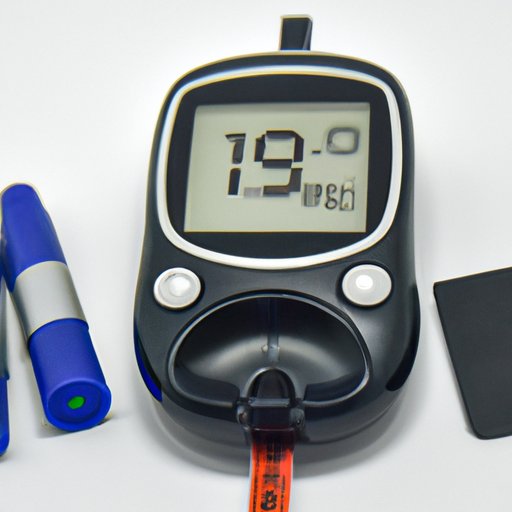
I. Introduction
Blood sugar levels can fluctuate throughout the day, especially for those with diabetes. One factor that can trigger a drop in blood sugar levels is exercise. While exercise is an essential component of overall health, it is essential to understand the relationship between exercise and blood sugar levels.
This article explores the link between exercise and blood sugar levels in detail and provides practical advice for using exercise to lower blood sugar levels.
II. The Benefits of Exercise on Blood Sugar Levels: A Look at How Much It Can Drop
Regular exercise has many health benefits, including improved blood sugar control. In fact, exercise is one of the most effective ways to lower blood sugar levels.
When we exercise, our muscles use glucose for energy. This glucose uptake helps lower blood sugar levels and improve insulin sensitivity, allowing our bodies to use insulin more efficiently.
The extent to which exercise can lower blood sugar levels varies depending on factors such as the type of exercise, its intensity, and the timing of your pre-workout meal. However, it is estimated that exercise can lower blood sugar levels by up to 50 points or more in some cases.
III. Understanding the Relationship between Exercise and Blood Sugar Levels
The link between exercise and blood sugar levels is complex. During exercise, our bodies need an energy source to power our muscles. This energy comes from glucose stored in the liver and muscles or from the bloodstream.
As we exercise, our muscles use up glucose, causing blood sugar levels to drop. Our bodies respond by releasing glucose from the liver to maintain a steady supply of energy. However, the release of glucose is slower than the uptake by muscle, leading to the overall drop in blood sugar levels.
Additionally, other factors can affect how much blood sugar levels drop during exercise, such as insulin sensitivity and the type and duration of exercise.
IV. How Much Should Your Blood Sugar Drop After Exercise?
A significant drop in blood sugar levels after exercise is generally considered to be a decrease of 50 mg/dl or more.
The extent to which blood sugar levels drop after exercise varies depending on the type and intensity of exercise. High-intensity workouts are more likely to cause a significant drop in blood sugar levels than low-intensity workouts.
It is generally recommended that blood sugar levels remain within a healthy range of 100 to 250 mg/dl during exercise. However, the ideal range depends on individual factors such as age, weight, and fitness level.
V. The Importance of Exercise in Controlling Blood Sugar Fluctuations
Exercise is an essential component of overall health, especially for those with diabetes. Physical activity can help control blood sugar fluctuations and improve overall well-being.
Regular exercise can lead to long-term benefits for blood sugar control, such as improved insulin sensitivity and glucose uptake. Additionally, regular exercise can complement other diabetes treatments such as medication and diet management.
It is important to consult with a healthcare professional before beginning an exercise program, especially if you have diabetes or any other medical conditions.
VI. From High to Low: Exercising Your Way to Healthier Blood Sugar Levels
Regular exercise can help lower blood sugar levels and improve overall health. There are specific exercises that can be helpful in managing blood sugar levels.
Aerobic exercise, also known as cardio, is an effective way to lower blood sugar levels. Examples of aerobic exercise include brisk walking, cycling, swimming, and dancing. Resistance training, such as weightlifting, can also help lower blood sugar levels and improve insulin sensitivity.
It is important to monitor blood sugar levels during exercise, especially if you are new to exercise or have diabetes. Monitoring devices such as blood glucose meters or continuous glucose monitors can help you track your blood sugar levels and adjust your exercise program accordingly.
VII. The Science behind Post-Exercise Blood Sugar Drops
The biological processes that lead to post-exercise blood sugar drops are complex. During exercise, our muscles use glucose for energy and remove it from the bloodstream, leading to a drop in blood sugar levels.
After exercise, our bodies respond by releasing glucose from the liver to maintain stable blood sugar levels. However, this process can be affected by factors such as insulin sensitivity, glycogen levels, and the type of exercise.
Pre-exercise and post-exercise meals can also influence blood sugar drops. It is generally recommended to consume a healthy meal or snack before exercise and to eat a carbohydrate-rich snack after exercise to replenish glycogen stores and prevent hypoglycemia.
VIII. Exercising for Diabetes: How Much Blood Sugar Reduction Can You Expect?
The blood sugar reduction you can expect from exercise varies depending on the type and intensity of exercise, as well as individual factors such as fitness level, age, and weight.
Aerobic exercise can lower blood sugar levels by up to 50 points or more, while resistance training can lead to a more gradual decline in blood sugar levels. It is recommended to aim for at least 150 minutes of moderate-intensity exercise per week as part of a diabetes management plan.
It is essential to work with a healthcare professional to create an individualized exercise plan that takes into account your specific medical history and goals. Additionally, medications such as insulin or oral hypoglycemic agents can affect blood sugar reduction during exercise and should be monitored carefully.
IX. Conclusion
In conclusion, exercise is an essential component of blood sugar control for those with diabetes. Regular exercise can lead to significant drops in blood sugar levels and long-term benefits for overall health.
However, it is essential to understand the relationship between exercise and blood sugar levels and to work with a healthcare professional to create an individualized exercise program. Monitoring devices such as blood glucose meters or continuous glucose monitors can help track blood sugar levels during exercise and adjust the program accordingly.
Incorporating exercise into your diabetes management plan can lead to improved blood sugar control, increased energy, and overall well-being.





